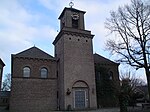Loo, Duiven
DuivenGelderland geography stubsLingewaardPopulated places in Gelderland

Loo is a village in the municipality of Duiven in the province of Gelderland, the Netherlands. The village has a ferry connection to Huissen. A couple of houses of Loo are part of Huissen, Lingewaard, because they were on a former river island which used to belong the Duchy of Cleves.
Excerpt from the Wikipedia article Loo, Duiven (License: CC BY-SA 3.0, Authors, Images).Loo, Duiven
Sloetstraat, Duiven
Geographical coordinates (GPS) Address Nearby Places Show on map
Geographical coordinates (GPS)
| Latitude | Longitude |
|---|---|
| N 51.929 ° | E 5.989 ° |
Address
Sloetstraat 1
6924 AW Duiven
Gelderland, Netherlands
Open on Google Maps









